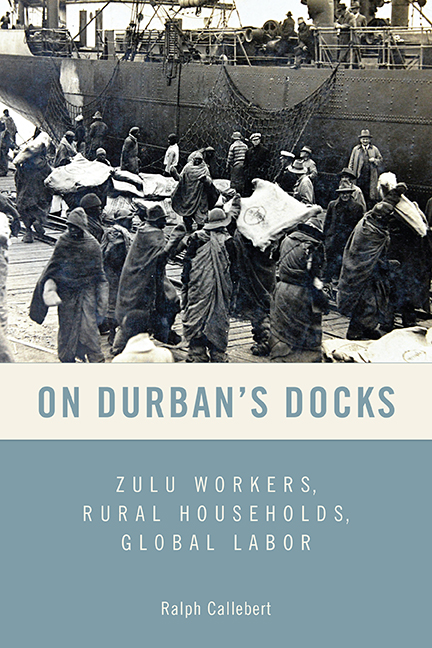Book contents
- Frontmatter
- Dedication
- Contents
- List of Maps
- Acknowledgments
- Abbreviations
- Introduction: Dock Workers in South African History
- 1 Dock Workers and the City, 1910s to 1950s
- 2 One Head of Cattle Named Salt, Another Named Beans: Livelihood Strategies in the 1950s
- 3 Work and Life between the City and the Countryside
- 4 My Children Never Went to Bed Hungry: Gender, Households, and Reproductive Labor
- 5 Cleaning the Wharves: Pilferage, Bribery, and Informal Trade
- 6 Buffaloes on Noah’s Ark: Reimagining Working-Class History
- Conclusion: Durban’s Dock Workers in Global Perspective
- Epilogue
- Notes
- Glossary
- Bibliography
- Index
Conclusion: Durban’s Dock Workers in Global Perspective
Published online by Cambridge University Press: 29 May 2021
- Frontmatter
- Dedication
- Contents
- List of Maps
- Acknowledgments
- Abbreviations
- Introduction: Dock Workers in South African History
- 1 Dock Workers and the City, 1910s to 1950s
- 2 One Head of Cattle Named Salt, Another Named Beans: Livelihood Strategies in the 1950s
- 3 Work and Life between the City and the Countryside
- 4 My Children Never Went to Bed Hungry: Gender, Households, and Reproductive Labor
- 5 Cleaning the Wharves: Pilferage, Bribery, and Informal Trade
- 6 Buffaloes on Noah’s Ark: Reimagining Working-Class History
- Conclusion: Durban’s Dock Workers in Global Perspective
- Epilogue
- Notes
- Glossary
- Bibliography
- Index
Summary
There is a contradiction at the core of the lives and livelihoods of Durban's dock workers. These migrant laborers performed the hard work necessary to connect South Africa and the subcontinent to global markets. Working in South Africa's largest harbor, they handled most of the country's imports and exports. They were thus crucial to the integration of southern Africa into global networks of trade, communication, and capital. Discourses on globalization, which often conflate globalization and financialization, seldom pay much attention to labor, except when performed in sweatshops or offshored from the West. However, it was the hard work of transport laborers around the world, as well as that of industrial, agricultural, and other workers, that enabled the expansion of global trade and capitalist exploitation. Nevertheless, as African rural migrants under apartheid, Durban's dock workers did not reap rewards commensurate with their seminal role in servicing the country's international trade, neither in legal status nor in economic compensation. Not only were these workers shortchanged, their livelihoods also did not reflect the global connectedness that their labor made possible. Rather, their social and economic lives were thoroughly rooted in local rural economies and remarkably disconnected from the global networks of trade and communication they served. Thus, while the recent turn to the Indian Ocean world offers many exciting new perspectives in South African historiography, I was more interested in looking inland to the workers’ rural homes and households.
Thinking about ports and shipping can too easily lead us to prioritize cosmopolitanism and global connections over withdrawal and exclusion from the world of shipping and global mobility. Yet the latter phenomena were at least as important to the lives of these dock workers. Likewise, academics and policy makers have often tended to find their ideal subjects, regardless of whether these are proletarian radicals or neoliberally celebrated entrepreneurs, among African workers and the African poor (see the introduction). Both of these accounts of African labor rely on a similar assumption that global connections and the spread of capitalism somehow flatten social relations.
- Type
- Chapter
- Information
- On Durban's DocksZulu Workers, Rural Households, Global Labor, pp. 152 - 164Publisher: Boydell & BrewerPrint publication year: 2018

